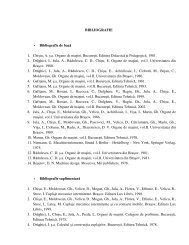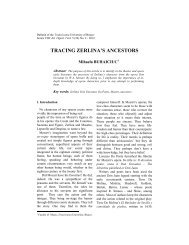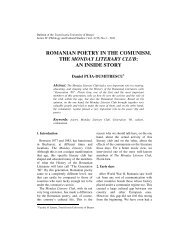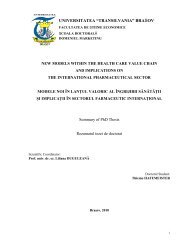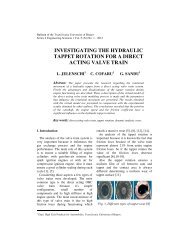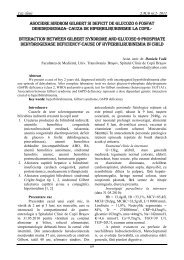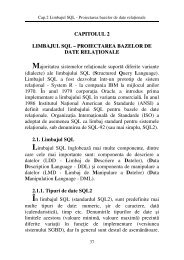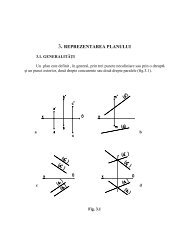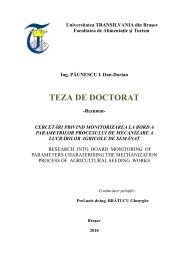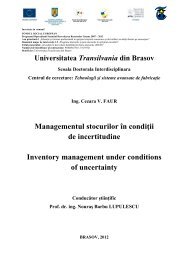the concept of intertextuality in gheorghe crăciun's novels
the concept of intertextuality in gheorghe crăciun's novels
the concept of intertextuality in gheorghe crăciun's novels
Create successful ePaper yourself
Turn your PDF publications into a flip-book with our unique Google optimized e-Paper software.
Bullet<strong>in</strong> <strong>of</strong> <strong>the</strong> Transilvania University <strong>of</strong> Braşov<br />
Series IV: Philology and Cultural Studies • Vol. 6 (55) No. 2 - 2013<br />
THE CONCEPT OF INTERTEXTUALITY<br />
IN GHEORGHE CRĂCIUN’S NOVELS<br />
Alexandra UNGUREANU-ATĂNĂSOAIE 1<br />
Abstract: The current paper <strong>in</strong>vestigates <strong>the</strong> <strong>concept</strong> <strong>of</strong> <strong><strong>in</strong>tertextuality</strong> as it<br />
is depicted <strong>in</strong> Gheorghe Crăciun’s first four <strong>novels</strong>. With Gheorghe Crăciun,<br />
this <strong>concept</strong> goes beyond its def<strong>in</strong>ition from <strong>the</strong> <strong>the</strong>ory <strong>of</strong> literature and,<br />
<strong>in</strong>stead, it establishes itself more like a paradigm <strong>in</strong> which one can f<strong>in</strong>d<br />
subtypes <strong>of</strong> <strong><strong>in</strong>tertextuality</strong>. This paper aims at <strong>in</strong>vestigat<strong>in</strong>g <strong>the</strong>se subtypes<br />
and at establish<strong>in</strong>g <strong>the</strong> relationships Gheorghe Crăciun’s first four <strong>novels</strong><br />
hold with o<strong>the</strong>r texts, belong<strong>in</strong>g ei<strong>the</strong>r to <strong>the</strong> world literature (both old and<br />
new, or to Romanian literature (aga<strong>in</strong>, both old and contemporary).<br />
Key words: <strong><strong>in</strong>tertextuality</strong>, <strong>in</strong>ternal <strong><strong>in</strong>tertextuality</strong>, external <strong><strong>in</strong>tertextuality</strong>.<br />
1. Introduction<br />
The <strong>concept</strong> <strong>of</strong> <strong><strong>in</strong>tertextuality</strong> has had,<br />
up until now, a relatively short career <strong>in</strong><br />
<strong>the</strong> field <strong>of</strong> literary <strong>the</strong>ory. Approximately<br />
50 years <strong>of</strong> age, this <strong>concept</strong> has come to<br />
occupy centre stage once postmodernism<br />
became an <strong>in</strong>evitable cultural and literary<br />
phenomenon. Nowadays, one can f<strong>in</strong>d<br />
<strong>in</strong>stances <strong>of</strong> <strong><strong>in</strong>tertextuality</strong> everywhere, be<br />
it a contemporary postmodern novel or<br />
even a TV series. This does not mean,<br />
however, that this <strong>concept</strong> is <strong>the</strong> <strong>in</strong>vention<br />
<strong>of</strong> postmodern writers. As it is well known,<br />
<strong>in</strong>stances <strong>of</strong> <strong><strong>in</strong>tertextuality</strong> can be found <strong>in</strong><br />
<strong>the</strong> works <strong>of</strong> some classical writers<br />
(Laurence Sterne with his famous Life and<br />
Op<strong>in</strong>ions <strong>of</strong> Tristram Shandy, Gentleman<br />
be<strong>in</strong>g a f<strong>in</strong>e example), although with a<br />
much less solid <strong>the</strong>oretical framework than<br />
<strong>in</strong> <strong>the</strong> case <strong>of</strong> postmodernism.<br />
A short history <strong>of</strong> <strong>the</strong> <strong>concept</strong> is,<br />
however, necessary, and this will be<br />
covered <strong>in</strong> <strong>the</strong> next sub-section <strong>of</strong> this<br />
paper, to <strong>the</strong> purpose <strong>of</strong> establish<strong>in</strong>g its<br />
evolution, with <strong>the</strong> shifts <strong>in</strong> mean<strong>in</strong>g or <strong>in</strong><br />
perspective and <strong>in</strong> arriv<strong>in</strong>g to a functional<br />
def<strong>in</strong>ition <strong>of</strong> <strong>the</strong> term. The question that<br />
arises at this po<strong>in</strong>t is whe<strong>the</strong>r <strong>the</strong><br />
established def<strong>in</strong>ition <strong>of</strong> <strong>the</strong> term is an<br />
operational one or whe<strong>the</strong>r <strong>the</strong>re is a need<br />
for ref<strong>in</strong>ement, hav<strong>in</strong>g <strong>in</strong> m<strong>in</strong>d <strong>the</strong> way <strong>in</strong><br />
which Gheorghe Crăciun puts this<br />
<strong>concept</strong> <strong>in</strong>to action <strong>in</strong> his <strong>novels</strong>.<br />
Moreover, ano<strong>the</strong>r po<strong>in</strong>t to aim for is to<br />
determ<strong>in</strong>e whe<strong>the</strong>r <strong>the</strong> use <strong>of</strong><br />
<strong><strong>in</strong>tertextuality</strong> is a mere playful,<br />
postmodernist one or if <strong>the</strong>re is a deeper<br />
reason beh<strong>in</strong>d it. The case with Gheorghe<br />
Crăciun could be that such a popular<br />
<strong>concept</strong> among postmodernist writers is<br />
not put <strong>in</strong>to play, <strong>in</strong> his first four <strong>novels</strong>,<br />
just for <strong>the</strong> sake <strong>of</strong> us<strong>in</strong>g it. One has to<br />
always keep <strong>in</strong> m<strong>in</strong>d that a pr<strong>of</strong>oundly<br />
<strong>the</strong>oretical conscience, just like Crăciun’s<br />
was, could not help but strenghten his<br />
literary writ<strong>in</strong>gs with a deep <strong>the</strong>oretical<br />
background. The easiest example that<br />
comes to m<strong>in</strong>d is <strong>the</strong> case <strong>of</strong> <strong>the</strong><br />
dist<strong>in</strong>ction Crăciun uses as a foundations<br />
1 PhD candidate, Faculty <strong>of</strong> Letters, Transilvania University <strong>of</strong> Braşov.
14<br />
Bullet<strong>in</strong> <strong>of</strong> <strong>the</strong> Transilvania University <strong>of</strong> Braşov • Series IV • Vol. 6 (55) No. 2 - 2013<br />
for his work between writ<strong>in</strong>g and body, <strong>the</strong><br />
letter and <strong>the</strong> body. Crăciun can be<br />
anyth<strong>in</strong>g but a writer lack<strong>in</strong>g a <strong>the</strong>oretical<br />
frame <strong>of</strong> work and <strong>the</strong>re is always <strong>the</strong><br />
need, when analys<strong>in</strong>g his work, to see <strong>the</strong><br />
unbroken relationship between <strong>the</strong>ory and<br />
prose and <strong>the</strong> way <strong>in</strong> which he chooses, <strong>in</strong><br />
his literary writ<strong>in</strong>gs, to redef<strong>in</strong>e certa<strong>in</strong><br />
<strong>concept</strong>s that he concerns himself about <strong>in</strong><br />
his <strong>the</strong>oretical works.<br />
2. Intertextuality: a brief history <strong>of</strong> <strong>the</strong><br />
<strong>concept</strong><br />
Crăciun himself dwelled upon <strong>the</strong><br />
evolution <strong>of</strong> <strong>the</strong> <strong>concept</strong> <strong>of</strong> <strong><strong>in</strong>tertextuality</strong><br />
<strong>in</strong> one <strong>of</strong> his <strong>the</strong>oretical works,<br />
Introduction <strong>in</strong> <strong>the</strong> <strong>the</strong>ory <strong>of</strong> literature,<br />
where, from a didactic po<strong>in</strong>t <strong>of</strong> view (one<br />
should not forget that <strong>the</strong> above mentioned<br />
work was used as a course for first year<br />
students), he <strong>in</strong>sisted upon establish<strong>in</strong>g<br />
<strong><strong>in</strong>tertextuality</strong> as a <strong>concept</strong>. This<br />
exploration does not neccesarily<br />
consider<strong>in</strong>g Gheorghe Crăciun’s view as<br />
be<strong>in</strong>g fully explored It is not, which is<br />
however understandable if one takes <strong>in</strong>to<br />
account <strong>the</strong> fact that after <strong>the</strong> moment <strong>the</strong><br />
book had appeared, <strong>the</strong>re were published a<br />
lot <strong>of</strong> new titles on <strong>the</strong> subject <strong>of</strong><br />
<strong><strong>in</strong>tertextuality</strong>. Never<strong>the</strong>less, for a purely<br />
diachonic po<strong>in</strong>t <strong>of</strong> view, Crăciun’s<br />
presentation <strong>of</strong> <strong>the</strong> term is useful for any<br />
fur<strong>the</strong>r research.<br />
Hav<strong>in</strong>g said that, it should be noted that<br />
<strong>the</strong>re is a certa<strong>in</strong> disparity between <strong>the</strong><br />
moment when <strong>the</strong> mean<strong>in</strong>g <strong>of</strong> <strong>the</strong> <strong>concept</strong><br />
was firstly used (<strong>in</strong> Mihail Bakht<strong>in</strong>’s 1929<br />
book on <strong>the</strong> poetics <strong>of</strong> Dostoievski) and<br />
<strong>the</strong> one when it was <strong>of</strong>icially named as<br />
such, by Julia Kristeva <strong>in</strong> <strong>the</strong> 60s. Whereas<br />
Bakht<strong>in</strong> def<strong>in</strong>ed <strong><strong>in</strong>tertextuality</strong> as a<br />
,,relation <strong>of</strong> an utterance with ano<strong>the</strong>r<br />
utterance”, a characteristics <strong>of</strong> any literary<br />
discourse (apud Crăciun, 46), Kristeva [9]<br />
adds that a text not only establishes<br />
relations with its own parts but also with<br />
o<strong>the</strong>r texts. Graham Allen [1] <strong>in</strong>sists on<br />
this particular moment <strong>in</strong> <strong>the</strong> evolution <strong>of</strong><br />
<strong>the</strong> <strong>concept</strong>. Gerard Genette [8] marks yet<br />
ano<strong>the</strong>r important moment because he puts<br />
forward a system <strong>in</strong> six po<strong>in</strong>ts for<br />
<strong><strong>in</strong>tertextuality</strong>, which comes under <strong>the</strong><br />
broader <strong>concept</strong> <strong>of</strong> transtextuality, which<br />
actually wasn’t successful at all.<br />
In <strong>the</strong> context <strong>of</strong> Romanian literature,<br />
Nicolae Manolescu [10] also co<strong>in</strong>ed a<br />
def<strong>in</strong>ition for <strong>the</strong> <strong>concept</strong> <strong>of</strong> <strong><strong>in</strong>tertextuality</strong>,<br />
regard<strong>in</strong>g it as ,,<strong>the</strong> subord<strong>in</strong>ation <strong>of</strong> <strong>the</strong><br />
text to <strong>the</strong> genre” In some po<strong>in</strong>ts, his<br />
perspective overlaps with Gerard<br />
Genette’s, but focuses more on <strong>the</strong> method<br />
<strong>of</strong> liais<strong>in</strong>g <strong>of</strong> <strong>the</strong> second text (<strong>the</strong> one<br />
where <strong>in</strong>tertext can be found) with <strong>the</strong><br />
orig<strong>in</strong>al one.<br />
Com<strong>in</strong>g back to Crăciun’s view on<br />
<strong><strong>in</strong>tertextuality</strong>, <strong>the</strong>re has to be said that he<br />
underl<strong>in</strong>es <strong>the</strong> consensus among <strong>the</strong><br />
specialists regard<strong>in</strong>g <strong>the</strong> forms <strong>of</strong><br />
<strong><strong>in</strong>tertextuality</strong>, ma<strong>in</strong>ly <strong>in</strong>ternal<br />
<strong><strong>in</strong>tertextuality</strong> (<strong>in</strong>side <strong>the</strong> literary text,<br />
consist<strong>in</strong>g <strong>of</strong> <strong>the</strong> <strong>in</strong>terrelations among <strong>the</strong><br />
elements <strong>of</strong> a text), <strong><strong>in</strong>tertextuality</strong> per se<br />
(<strong>the</strong> relations among literary texts) and<br />
external <strong><strong>in</strong>tertextuality</strong> (<strong>the</strong> relation <strong>of</strong> <strong>the</strong><br />
text with <strong>the</strong> text <strong>of</strong> <strong>the</strong> world).<br />
3. Redef<strong>in</strong><strong>in</strong>g <strong><strong>in</strong>tertextuality</strong> <strong>in</strong><br />
Gheorghe Crăciun’s <strong>novels</strong><br />
This tridimensional structure<br />
represented <strong>the</strong> foundation <strong>of</strong> <strong>the</strong> current<br />
perspective upon <strong><strong>in</strong>tertextuality</strong> <strong>in</strong><br />
Crăciun’s <strong>novels</strong>. It is <strong>in</strong> fact a dichotomy<br />
which required redef<strong>in</strong><strong>in</strong>g <strong>in</strong> such a way<br />
that it would not force <strong>the</strong> text to fit a<br />
formula that is alien to it. It can be said<br />
that <strong>the</strong> texts <strong>the</strong>mselves asked for its<br />
tools for analysis and thus <strong>the</strong> current<br />
perspective can be considered as be<strong>in</strong>g an<br />
<strong>in</strong>dividual <strong>in</strong>stance. It could be an<br />
<strong>in</strong>terest<strong>in</strong>g endeavour to try and see o<strong>the</strong>r<br />
authors’ work us<strong>in</strong>g <strong>the</strong> tools this exact<br />
model has to <strong>of</strong>fer.
A. UNGUREANU-ATĂNĂSOAIE: The Concept <strong>of</strong> Intertextuality <strong>in</strong> … 15<br />
The current proposal preserves <strong>the</strong><br />
formal denom<strong>in</strong>ation for both external<br />
<strong><strong>in</strong>tertextuality</strong> and <strong>in</strong>ternal <strong><strong>in</strong>tertextuality</strong><br />
but <strong>the</strong> mean<strong>in</strong>g has been adapted <strong>in</strong> such a<br />
way that it fits <strong>in</strong> <strong>the</strong> context <strong>of</strong> <strong>the</strong> <strong>novels</strong>.<br />
At this po<strong>in</strong>t, <strong>the</strong>re is <strong>the</strong> need <strong>of</strong> a short<br />
discussion regard<strong>in</strong>g <strong>the</strong> po<strong>in</strong>t <strong>of</strong> view<br />
selected: <strong>the</strong> first and foremost th<strong>in</strong>g to<br />
note here is that <strong>the</strong>re is an <strong>in</strong>tegrative<br />
perspective at play when analys<strong>in</strong>g<br />
Crăciun’s <strong>novels</strong>, <strong>the</strong> first four ones be<strong>in</strong>g<br />
regarded as a whole (even if Pupa russa<br />
could seem, at <strong>the</strong> first sight, somehow as<br />
an outsider). None<strong>the</strong>less, this does not<br />
mean that <strong>the</strong> differences among <strong>novels</strong> are<br />
ignored, because <strong>the</strong> identity <strong>of</strong> each and<br />
every one <strong>of</strong> <strong>the</strong>m is fully respected.<br />
Moreover, it is possible to establish l<strong>in</strong>kes<br />
among <strong>novels</strong> (with <strong>the</strong> mention that, <strong>in</strong><br />
this frame <strong>of</strong> work, Acte orig<strong>in</strong>ale/Copii<br />
legalizate is considered someth<strong>in</strong>g more<br />
than a collection <strong>of</strong> short stories, actually a<br />
novel <strong>in</strong> itself, with arguments provided by<br />
<strong>the</strong> current proposal).<br />
3.1. Internal <strong><strong>in</strong>tertextuality</strong><br />
Thus, <strong>in</strong> <strong>the</strong> context <strong>of</strong> this study, <strong>in</strong>ternal<br />
<strong><strong>in</strong>tertextuality</strong> will be def<strong>in</strong>ed as any relation<br />
among <strong>the</strong> author’s first four <strong>novels</strong>, keep<strong>in</strong>g<br />
<strong>in</strong> m<strong>in</strong>d <strong>the</strong> fact that <strong>the</strong> connections can also<br />
be established with diaries such as Trupul<br />
ştie mai mult or with o<strong>the</strong>r <strong>the</strong>oretical works.<br />
This necessary ref<strong>in</strong>ement puts <strong>in</strong> context <strong>the</strong><br />
easily noticeable connections among <strong>the</strong> first<br />
three <strong>novels</strong> and <strong>the</strong> slightly less noticeable<br />
ones with Pupa russa. Moreover, this<br />
perspective also aims to prove that <strong>the</strong> four<br />
titles are just as many expressions <strong>of</strong> <strong>the</strong><br />
same outlook on literature, life and writ<strong>in</strong>g<br />
but, at <strong>the</strong> same time, that <strong>the</strong>re is room for<br />
evolution.<br />
The connections can be noticed at<br />
multiple levels. First <strong>of</strong> all, <strong>the</strong>re is<br />
<strong><strong>in</strong>tertextuality</strong> at <strong>the</strong> level <strong>of</strong> <strong>the</strong> text itself:<br />
<strong>the</strong>re are migrations <strong>of</strong> parts <strong>of</strong> texts from<br />
one novel to ano<strong>the</strong>r, or even with<strong>in</strong> <strong>the</strong><br />
same text, just like <strong>in</strong> <strong>the</strong> case <strong>of</strong> Munte<br />
(proiect de imag<strong>in</strong>e), <strong>in</strong>serted <strong>in</strong><br />
Fragmente d<strong>in</strong>tr-un fals tratat de<br />
alp<strong>in</strong>ologie, both parts <strong>of</strong> Acte<br />
orig<strong>in</strong>ale/Copii legalizate.<br />
Ano<strong>the</strong>r case is that <strong>of</strong> <strong>the</strong> characters,<br />
some <strong>of</strong> which seem to freely migrate from<br />
one novel to ano<strong>the</strong>r, and <strong>the</strong> reader can<br />
see <strong>the</strong>m at different ages, with more or<br />
less <strong>the</strong> same problems, obsessions and<br />
struggles (it is <strong>the</strong> case <strong>of</strong> mascul<strong>in</strong>e<br />
characters, such as Vlad Ştefan, Octavian<br />
Cost<strong>in</strong> and <strong>the</strong> mysterious George) and<br />
o<strong>the</strong>rs simply evolve or are presented as<br />
variants <strong>of</strong> <strong>the</strong> same archetype (Liana<br />
Şanta-Ioana Jighira-Leont<strong>in</strong>a Guran). The<br />
same model variant-archetype can be<br />
noticed as well <strong>in</strong> Compunere cu paralele<br />
<strong>in</strong>egale where each and every couple is<br />
actually a more or less successful copy <strong>of</strong><br />
<strong>the</strong> Dafnis and Chloe couple (<strong>in</strong> relation <strong>of</strong><br />
external <strong><strong>in</strong>tertextuality</strong> with Longos’s<br />
characters Dafnis and Chloe).<br />
3.2. External <strong><strong>in</strong>tertextuality</strong><br />
External <strong><strong>in</strong>tertextuality</strong>, as will be<br />
def<strong>in</strong>ed as follows, comes more closely to<br />
<strong>the</strong> orig<strong>in</strong>al mean<strong>in</strong>g <strong>of</strong> <strong><strong>in</strong>tertextuality</strong>, but<br />
without confound<strong>in</strong>g itself with it,<br />
demand<strong>in</strong>g, yet aga<strong>in</strong>, a process <strong>of</strong><br />
redef<strong>in</strong><strong>in</strong>g to <strong>the</strong> purpose <strong>of</strong> a better<br />
adherence to Gheorghe Crăciun’s <strong>novels</strong>.<br />
Thus, external <strong><strong>in</strong>tertextuality</strong> means, <strong>in</strong> <strong>the</strong><br />
context <strong>of</strong> this paper, more than just ,,a<br />
relation <strong>of</strong> a text with ano<strong>the</strong>r text, <strong>of</strong> any<br />
k<strong>in</strong>d” but ,,<strong>the</strong> relationship established by<br />
Crăciun’s text (<strong>in</strong> general) with o<strong>the</strong>r<br />
literary texts belong<strong>in</strong>g to authors o<strong>the</strong>r<br />
than him, <strong>the</strong> authors rang<strong>in</strong>g from<br />
Antiquity to contemporaneity and from<br />
world literature to <strong>the</strong> Romanian one”.<br />
Obviously, this is a s<strong>in</strong>gular <strong>in</strong>terpretation<br />
for <strong>the</strong> newly appo<strong>in</strong>ted sub-<strong>concept</strong> and,<br />
aga<strong>in</strong>, it would be very <strong>in</strong>terest<strong>in</strong>g to see if<br />
it can be applied to <strong>the</strong> works <strong>of</strong> o<strong>the</strong>r<br />
writers.
16<br />
Bullet<strong>in</strong> <strong>of</strong> <strong>the</strong> Transilvania University <strong>of</strong> Braşov • Series IV • Vol. 6 (55) No. 2 - 2013<br />
The first th<strong>in</strong>g to note here is <strong>the</strong> wide<br />
extension <strong>of</strong> references: Crăciun moves<br />
freely from Longos’s Dafnis and Cloe to<br />
Mircea Nedelciu, for example. Ano<strong>the</strong>r<br />
observation to make is that <strong>the</strong> first four<br />
<strong>novels</strong> are not consistent at all <strong>in</strong> what<br />
concerns <strong>the</strong> external <strong><strong>in</strong>tertextuality</strong>. In this<br />
respect, Acte orig<strong>in</strong>ale/Copii legalizate and<br />
Compunere cu paralele <strong>in</strong>egale (this novel<br />
more than <strong>the</strong> previous) are <strong>the</strong> titles where<br />
one can f<strong>in</strong>d <strong>in</strong>stances rang<strong>in</strong>g from mere<br />
allusions to fully established quotations.<br />
Frumoasa fără corp and Pupa russa both<br />
mark a new <strong>in</strong>terpretation <strong>of</strong> this <strong>concept</strong>,<br />
each <strong>of</strong> <strong>the</strong>m establish<strong>in</strong>g one ma<strong>in</strong><br />
external <strong>in</strong>tertext: <strong>the</strong> first with Em<strong>in</strong>escu’s<br />
Miron şi frumoasa fără corp (<strong>the</strong> version<br />
<strong>in</strong> prose) and <strong>the</strong> latter with Gustave<br />
Flaubert’s Madame Bovary. Both<br />
Frumoasa fără corp and Pupa russa can<br />
be considered, from this po<strong>in</strong>t <strong>of</strong> view, as<br />
ultimate moments <strong>of</strong> writ<strong>in</strong>g raf<strong>in</strong>ement.<br />
What looks like a dim<strong>in</strong>ishment <strong>of</strong> <strong>the</strong><br />
outflow with world’s literature is actually a<br />
mature decision, <strong>the</strong> writer choos<strong>in</strong>g wellestablished<br />
titles to audaciously<br />
re<strong>in</strong>terprete and it is not accidental at all<br />
that Crăciun selects one <strong>of</strong> Em<strong>in</strong>escu’s and<br />
Flaubert’s works to work upon.<br />
There are multiple <strong>in</strong>stances <strong>of</strong> external<br />
<strong><strong>in</strong>tertextuality</strong> <strong>in</strong> Crăciun’s <strong>novels</strong>: <strong>in</strong> Acte<br />
orig<strong>in</strong>ale/Copii legalizate: with Al.<br />
Brătescu Vo<strong>in</strong>eşti’s Puiul, l<strong>in</strong>es from<br />
Arghezi’s poems, Am<strong>in</strong>tiri d<strong>in</strong> copilărie, <strong>in</strong><br />
Compunere cu paralele <strong>in</strong>egale, with<br />
Groşan’s Insula, Calderon de Barca’s<br />
def<strong>in</strong>ition <strong>of</strong> life as a dream, Goga’s<br />
archetypal female teacher, Radu Petrescu’s<br />
Matei Iliescu, Geo Bogza’s O sută de<br />
m<strong>in</strong>ute, Mircea Nedelciu’s Voiaj chimic,<br />
<strong>the</strong> quotations at <strong>the</strong> beg<strong>in</strong>n<strong>in</strong>g <strong>of</strong> each<br />
Epură pentru Longos and Longos’s Dafnis<br />
and Cloe. The same pattern, that <strong>of</strong> us<strong>in</strong>g<br />
quotations, is also used <strong>in</strong> Pupa russa, <strong>in</strong><br />
<strong>the</strong> <strong>in</strong>vented newspaper articles. The<br />
<strong>in</strong>tertext with Flaubert’s Madame Bovary<br />
can be considered <strong>the</strong> f<strong>in</strong>est demonstration<br />
<strong>of</strong> Crăciun’s writ<strong>in</strong>g, this relationship<br />
be<strong>in</strong>g so visible <strong>in</strong> some po<strong>in</strong>ts and so<br />
subtle <strong>in</strong> o<strong>the</strong>rs that it could be analyzed on<br />
numerous pages.<br />
The last <strong>of</strong> Crăciun’s published <strong>novels</strong>,<br />
Femei albastre was not <strong>in</strong>cluded <strong>in</strong> <strong>the</strong><br />
present proposal, as <strong>the</strong> author will<strong>in</strong>gly<br />
and publicly abandoned any type <strong>of</strong><br />
references and <strong>in</strong>stead wanted to focus<br />
more on events. None<strong>the</strong>less, his real<br />
<strong>in</strong>tentions must be fur<strong>the</strong>r <strong>in</strong>vestigated, as<br />
<strong>the</strong> apparent lack <strong>of</strong> obvious references and<br />
<strong>the</strong> centrality <strong>of</strong> movie figures such as<br />
Nicole Kidman can actually disguise<br />
someth<strong>in</strong>g more.<br />
References<br />
1. Allan, G.: Intertextuality. London.<br />
Routlege, 2000.<br />
2. Crăciun, G.: Orig<strong>in</strong>al Documents/<br />
Legalized Copies. Bucureşti. Cartea<br />
Românescă, 1982.<br />
3. Crăciun, G.: Bucureşti. Composition<br />
with Unequal Paralells. Alfa, 1999.<br />
4. Crăciun, G.: Disembodied Beauty.<br />
Bucureşti. Grupul Editorial Art, 2007.<br />
5. Crăciun, G.: Russian Doll. Bucureşti.<br />
Grupul Editorial Art, 2007.<br />
6. Crăciun, G.: Blue Women. Iaşi.<br />
Polirom, 2013.<br />
7. Crăciun, G.: An Introduction to <strong>the</strong><br />
Theory <strong>of</strong> Literature. Chiş<strong>in</strong>ău. Cartier<br />
Educaţional, 2003.<br />
8. Genette, G.: Palimpsestes. La<br />
litterature au second degree. Paris.<br />
Editions du Seuil, 1982.<br />
9. Kristeva, J.: Desire <strong>in</strong> Language: A<br />
Semiotic Approach to Litterature and<br />
Art. New York. Columbia University<br />
Press, 1980.<br />
10. Manolescu, N.: On Poetry. Braşov.<br />
Aula, 2002.



